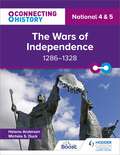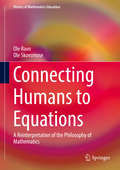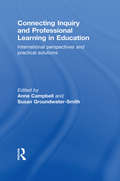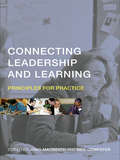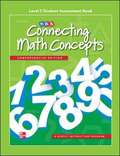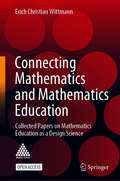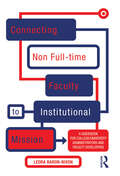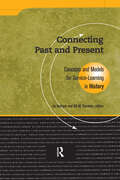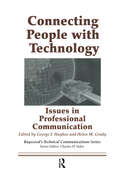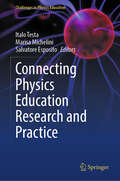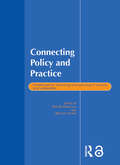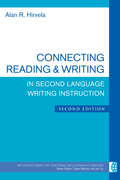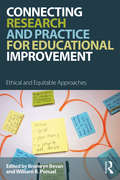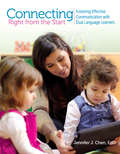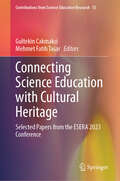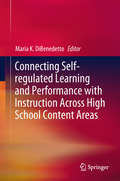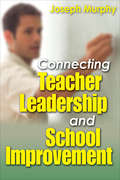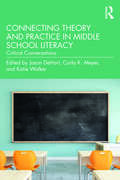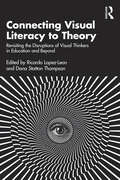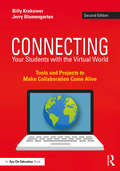- Table View
- List View
Connecting History: National 4 & 5 The Era of the Great War, 1900–1928
by Alec JessopExam board: SQALevel: National 4 & 5Subject: HistoryFirst teaching: September 2017First assessment: Summer 2018Fresh stories, fresh scholarship and a fresh structure. Connecting History informs and empowers tomorrow's citizens, today.Bringing together lesser-told narratives, academic excellence, accessibility and a sharp focus on assessment success, this series provides a rich, relevant and representative History curriculum.> Connect the past to the present. Overarching themes of social justice, equality, change and power help students to understand the importance of events and issues, then and now.> Go far beyond other resources. With respect and aspiration for the transformative power of History, this series incorporates the latest research, challenges old interpretations and embeds diverse experiences throughout.> Follow a clear and consistent structure. The key issues in the N5 specification form the chapters in each book, and the content descriptors are subheadings within the chapters. Finding the information that you need has never been easier.> Meet the demands of the assessments. Connecting History develops the knowledge and skills for success, with appropriate breadth, depth and pace. The narrative and sources take centre stage and the authors model the process of answering questions effectively through that narrative, ensuring that students know all the key points that they need to. Activities throughout each chapter consolidate and extend learning.> Benefit from pedagogic and academic expertise. The authors are highly experienced teachers and examiners who know how to spark critical curiosity in students. Each book has been rigorously reviewed by an academic from the University of Glasgow, so you can rest assured that the content is accurate and up to date.
Connecting History: National 4 & 5 The Wars of Independence, 1286–1328
by Michèle Sine Duck Helena AndersonExam board: SQALevel: National 4 & 5Subject: HistoryFirst teaching: September 2017First assessment: Summer 2018Fresh stories, fresh scholarship and a fresh structure. Connecting History informs and empowers tomorrow's citizens, today.Bringing together lesser-told narratives, academic excellence, accessibility and a sharp focus on assessment success, this series provides a rich, relevant and representative History curriculum.> Connect the past to the present. Overarching themes of social justice, equality, change and power help students to understand the importance of events and issues, then and now.> Go far beyond other resources. With respect and aspiration for the transformative power of History, this series incorporates the latest research, challenges old interpretations and embeds diverse experiences throughout.> Follow a clear and consistent structure. The key issues in the N5 specification form the chapters in each book, and the content descriptors are subheadings within the chapters. Finding the information that you need has never been easier.> Meet the demands of the assessments. Connecting History develops the knowledge and skills for success, with appropriate breadth, depth and pace. The narrative and sources take centre stage and the authors model the process of answering questions effectively through that narrative, ensuring that students know all the key points that they need to. Activities throughout each chapter consolidate and extend learning.> Benefit from pedagogic and academic expertise. The authors are highly experienced teachers and examiners who know how to spark critical curiosity in students. Each book has been rigorously reviewed by an academic from the University of Glasgow, so you can rest assured that the content is accurate and up to date.
Connecting History: National 4 & 5 The Wars of Independence, 1286–1328
by Michèle Sine Duck Helena AndersonExam board: SQALevel: National 4 & 5Subject: HistoryFirst teaching: September 2017First assessment: Summer 2018Fresh stories, fresh scholarship and a fresh structure. Connecting History informs and empowers tomorrow's citizens, today.Bringing together lesser-told narratives, academic excellence, accessibility and a sharp focus on assessment success, this series provides a rich, relevant and representative History curriculum.> Connect the past to the present. Overarching themes of social justice, equality, change and power help students to understand the importance of events and issues, then and now.> Go far beyond other resources. With respect and aspiration for the transformative power of History, this series incorporates the latest research, challenges old interpretations and embeds diverse experiences throughout.> Follow a clear and consistent structure. The key issues in the N5 specification form the chapters in each book, and the content descriptors are subheadings within the chapters. Finding the information that you need has never been easier.> Meet the demands of the assessments. Connecting History develops the knowledge and skills for success, with appropriate breadth, depth and pace. The narrative and sources take centre stage and the authors model the process of answering questions effectively through that narrative, ensuring that students know all the key points that they need to. Activities throughout each chapter consolidate and extend learning.> Benefit from pedagogic and academic expertise. The authors are highly experienced teachers and examiners who know how to spark critical curiosity in students. Each book has been rigorously reviewed by an academic from the University of Glasgow, so you can rest assured that the content is accurate and up to date.
Connecting Humans to Equations: A Reinterpretation of the Philosophy of Mathematics (History of Mathematics Education)
by Ole Skovsmose Ole RavnConnecting Humans to Equations: A Reinterpretation of the Philosophy of Mathematics presents some of the most important positions in the philosophy of mathematics, while adding new dimensions to this philosophy. Mathematics is an integral part of human and social life, meaning that a philosophy of mathematics must include several dimensions. This book describes these dimensions by the following four questions that structure the content of the book: Where is mathematics? How certain is mathematics? How social is mathematics? How good is mathematics? These four questions refer to the ontological, epistemological, social, and ethical dimension of a philosophy of mathematics. While the ontological and epistemological dimensions have been explored in all classic studies in the philosophy of mathematics, the exploration of the book is unique in its social and ethical dimensions. It argues that the foundation of mathematics is deeply connected to human and social actions and that mathematics includes not just descriptive but also performative features. This human-centered and accessible interpretation of mathematics is relevant for students in mathematics, mathematics education, and any technical discipline and for anybody working with mathematics.
Connecting Inquiry and Professional Learning in Education: International Perspectives and Practical Solutions
by Anne Campbell Susan Groundwater-SmithHow might inquiry enhance the professional practice of student and practising teachers, teacher educators and other practitioners? What effect might this have on the learning of young people in and outside of the classroom? Based on the findings of an international colloquium and drawing upon a range of practices from the UK, USA, Canada, Europe and Australia, this book is designed to make explicit the connections between Practitioner Inquiry and Teacher Professional Learning in Initial Teacher Education and Ongoing Teacher Professional Development. Considering issues such as the relationship between practitioner inquiry and pedagogical content knowledge whether it is possible to scale up from small local and intensive innovations to more broadly-based inquiry inquiry’s role in professional identity, both individual and communal prevailing socio-political contexts and consequences for social policy formation. It brings together writers who work in designing teacher education courses, and those who are practice-based researchers and policy makers. Crucially, many of these writers inhabit both spheres, and their accounts of how they successfully combine their multiple roles will prove vital reading for all those involved in examining and improving practice leading to enhanced teacher professional learning.
Connecting Leadership and Learning: Principles for Practice
by Neil Dempster John MacBeathLeading schools is becoming almost daily a more complex and demanding job. Connecting Leadership and Learning reassesses the purpose of schools, the nature of learning and the qualities of leadership that make schools authentic places of learning. Starting with a review of what we can claim to know – and not know – about learning, leadership and their inter-relationship, this book explores what it means to lead schools that place learning at the centre. Drawing on research from seven different country projects - including the United States, Australia and five European countries – the authors offer five key principles for practice: a focus of learning an environment for learning a learning dialogue shared leadership accountability; internal and external. These key principles have been tested by teachers, senior leaders and school students and found to be applicable across cultural and linguistic boundaries. The challenges faced by in inner city schools, whether in London or New Jersey, prove a stern test for the five principles yet, as these schools testify, they bring a new sense of hope and resolve that learning is for everyone. Based on rigorous research yet thoroughly grounded in practice, this book aims to challenge the reader with big ideas about learning and leadership, and to break new ground in thinking about where leadership and learning meet so that practitioners can see how it works in school and classroom practice. It should be of interest to all school leaders and those aspiring to the role.
Connecting Math Concepts Level C Student Assessment Book
by Engelmann<P>The bus started out with 15 people. 32 more people got on the bus. How many people ended up on the bus?
Connecting Mathematics and Mathematics Education: Collected Papers on Mathematics Education as a Design Science
by Erich Christian WittmannThis open access book features a selection of articles written by Erich Ch. Wittmann between 1984 to 2019, which shows how the “design science conception” has been continuously developed over a number of decades. The articles not only describe this conception in general terms, but also demonstrate various substantial learning environments that serve as typical examples. In terms of teacher education, the book provides clear information on how to combine (well-understood) mathematics and methods courses to benefit of teachers. The role of mathematics in mathematics education is often explicitly and implicitly reduced to the delivery of subject matter that then has to be selected and made palpable for students using methods imported from psychology, sociology, educational research and related disciplines. While these fields have made significant contributions to mathematics education in recent decades, it cannot be ignored that mathematics itself, if well understood, provides essential knowledge for teaching mathematics beyond the pure delivery of subject matter. For this purpose, mathematics has to be conceived of as an organism that is deeply rooted in elementary operations of the human mind, which can be seamlessly developed to higher and higher levels so that the full richness of problems of various degrees of difficulty, and different means of representation, problem-solving strategies, and forms of proof can be used in ways that are appropriate for the respective level. This view of mathematics is essential for designing learning environments and curricula, for conducting empirical studies on truly mathematical processes and also for implementing the findings of mathematics education in teacher education, where it is crucial to take systemic constraints into account.
Connecting Non Full-time Faculty to Institutional Mission: A Guidebook for College/University Administrators and Faculty Developers
by Leora Baron-NixonNon full-time faculty—whether adjunct, part-time or contingent—has become the lifeline of a vast majority of colleges and universities. They teach many of the foundation and core courses taken by first- and second-year students, teach professional courses in which their own life experiences are invaluable, and step in at short notice to fill-in for regular faculty engaged in research or away on sabbaticals.A survey of over 4,000 institutions conducted by the US Department of Education reveals that such faculty are being hired at a much higher rate than their full-time counterparts--whether in response to increased enrollments, reduced budgets, or changing administrative strategies.The increasing presence of such faculty on campus can conflict with today’s demands for accountability and the pursuit of institutional mission. This book provides academic administrators and faculty developers with proactive, practical and results-producing approaches that can help transform fragmented faculties into integrated and cohesive teaching and scholarly communities.In an easy-to-follow format, this book constitutes a resource of thoughtful and pragmatic strategies to ensure quality and satisfaction both on the part of the institution and the adjuncts. Topics are presented in a thematic sequence that allows decision-makers to focus on their priority areas. The author offers guidance for systematic planning and implementation.The contents are focused on connecting non full-time faculty to core institutional functions and structures: Connection #1--to the institution; Connection #2--to the department; Connection #3--to teaching; Connection #4--to Students; and Connection #5--to scholarship.Originally announced as "Connecting Adjunct Faculty to the Academic Institution"
Connecting Past and Present: Concepts and Models for Service-Learning in History
by Ira Harkavy Bill M. DonovanThe question that animates volume, 16th in the Service-Learning in the Disciplines Series, is: Why connect service-learning to history courses? The contributors answer that question in different ways and illustrate and highlight a diversity of historical approaches and interpretations. All agree, however, that they do their jobs better as teachers (and in some cases as researchers) by engaging their students in service-learning. An interesting read with a compelling case for the importance of history and how service-learning can improve the historian’s craft.
Connecting People with Technology: Issues in Professional Communication (Baywood's Technical Communications)
by George F. HayhoeThis book explores five important areas where technology affects society, and suggests ways in which human communication can facilitate the use of that technology.Usability has become a foundational discipline in technical and professional communication that grows out of our rhetorical roots, which emphasize purpose and audience. As our appreciation of audience has grown beyond engineers and scientists to lay users of technology, our appreciation of the diversity of those audiences in terms of age, geography, and other factors has similarly expanded.We are also coming to grips with what Thomas Friedman calls the 'flat world,' a paradigm that influences how we communicate with members of other cultures and speakers of other languages. And because most of the flatteners are either technologies themselves or technology-driven, technical and professional communicators need to leverage these technologies to serve global audiences.Similarly, we are inundated with information about world crises involving health and safety issues. These crises are driven by the effects of terrorism, the aging population, HIV/AIDS, and both human-made and natural disasters. These issues are becoming more visible because they are literally matters of life and death. Furthermore, they are of special concern to audiences that technical and professional communicators have little experience targeting - the shapers of public policy, seniors, adolescents, and those affected by disaster.Biotechnology is another area that has provided new roles for technical and professional communicators. We are only beginning to understand how to communicate the science accurately without either deceiving or panicking our audience. We need to develop a more sophisticated understanding of how communication can shape reactions to biotechnology developments. Confronting this complex network of issues, we're challenged to fashion both our message and the audience's perceptions ethically.Finally, today's corporate environment is being shaped by technology and the global nature of business. Technical and professional communicators can play a role in capturing and managing knowledge, in using technology effectively in the virtual workplace, and in understanding how language shapes organizational culture.
Connecting Physics Education Research and Practice (Challenges in Physics Education)
by Salvatore Esposito Marisa Michelini Italo TestaThis book presents a selection of the most recent research results from the Italian physics education research community, aimed at enhancing the teaching and learning of physics. The motivation for this publication arises from the lack of a comprehensive reference for teachers on research results in physics education. Despite various physics curriculum reform initiatives, such as the introduction of modern physics into high school curricula, their effectiveness in improving the quality of physics teaching in schools has been limited. The book offers a contextualized view of the main topics in physics education, along with a comprehensive overview of the current challenges faced by physics education in Italy and abroad. It also presents research findings that could potentially enhance students' learning of physics. Throughout the book, the implications of these studies are outlined, acknowledging issues and knowledge gaps that will guide future research in physics education. Specifically, rather than covering all the contents addressed in the physics curriculum, the book presents research contributions that suggest potentially effective strategies, methods, and practices at different school levels, from primary school to secondary school and university level. Regarding physics content, the book presents teaching proposals highlighting conceptual aspects and exemplary methodologies of interpretation in physics, such as the physics of fluids and quantum mechanics. It also includes research contributions on different methods and proposals for implementing practical activities, reflecting on the role of the laboratory in learning the discipline and providing examples of integrating experimental and cognitive skills. The book also addresses the role of affective variables, such as physics identity, self-efficacy, and attitudes toward physics in the learning process. Additionally, studies on teachers&’ professional development are presented, which can inform the design of proposals for educational paths and methods, within a framework of close collaboration between schools and physics departments.
Connecting Policy and Practice: Challenges for Teaching and Learning in Schools and Universities
by Pam M. Denicolo Michael KompfWritten by members of the International Study Association on Teachers and Teaching, the papers in this volume were presented at an international teaching conference on the issues of theory and practice. Using these contributions from experienced researchers, most of whom are practising teachers, this single volume is international in scope and context, demonstrating differences and similarities between and within countries. This detailed book is clearly split into five sections focusing on the following themes: * teacher education – professional identity, professional research, and quality of teacher education* teacher practice – basic values, ethics, and cultural scaffolding* higher education – academic motivation, discourse dissonance concerning intellectual property, self studies of teacher education practice* teacher development – the challenge to be the best teacher, the link between policy and practice, personal theory and practice in tertiary development* research and theory – reflective practice, shared democratic values, teachers as researchers.
Connecting Reading & Writing in Second Language Writing Instruction, Second Edition
by Alan R. HirvelaIn this substantively revised new edition, Hirvela moves beyond the argument he made in the first edition of the value of connecting reading and writing. This new edition explains various dimensions of those connections and offers a fresh look at how to implement them in L2 writing instruction. It also provides both new and experienced teachers of writing with a solid grounding in the theoretical foundations and pedagogical possibilities associated with reading-writing connections. The new edition features two new chapters. The first is a chapter on assessment because students are now being asked to connect reading and writing in the classroom and on formal assessments like the TOEFL®. The second new chapter is an argument for accounting for transfer elements in the teaching and researching of reading-writing connections. The goals of this revised volume are to provide: resources for those wishing to pursue reading-writing connections, summaries of the beliefs underlying those connections, ideas for teaching the connections in the classroom, and information about the work others have done to develop this domain of L2 writing.
Connecting Reading and Writing in Second Language Writing Instruction
by Alan HirvelaAcademic writing often requires students to incorporate material from outside sources (like statistics, ideas, quotations, paraphrases) into their own written texts-a particular obstacle for students who lack strong reading skills. In Connecting Reading and Writing in Second Language Instruction, Alan Hirvela contends that second language writing students should be considered as readers first and advocates the integration of reading and writing instruction with a survey of theory, research, and pedagogy in the subject area. Although the integrated reading-writing model has gained popularity in recent years, many teachers have little more than an intuitive sense of the connections between these skills. As part of the popular Michigan Series on Teaching Multilingual Writers, Connecting Reading and Writing in Second Language Instruction will provide invaluable background knowledge on this issue to ESL teachers in training, as well as teachers who are already practicing.
Connecting Research and Practice for Educational Improvement: Ethical and Equitable Approaches
by Bronwyn Bevan William R. PenuelConnecting Research and Practice for Educational Improvement presents powerful arguments and richly illustrated cases for how more collaborative relationships between researchers and educators can yield more relevant research that impacts practice. This book can be useful for anyone teaching or learning about research–practice partnerships, in both school and out-of-school settings. The chapters highlight the different dispositions and skills needed to cultivate ethical relationships and promote equity through partnerships and provide rich frameworks for guiding future work.
Connecting Right From the Start: Fostering Effective Communication with Dual Language Learners
by Karen Nemeth Jennifer J. ChenConnecting with dual language learners (DLLs) is a growing reality among early childhood educators, who need to learn practical, proven strategies to reach these students. Grounded in research and strengthened by the author's personal experience as a student learning English, Connecting Right from the Start helps teachers understand the culturally and linguistically diverse children in their classroom, as well as those with disabilities.
Connecting Science Education with Cultural Heritage: Selected Papers from the ESERA 2023 Conference (Contributions from Science Education Research #15)
by Gultekin Cakmakci Mehmet Fatih TasarThis edited volume presents groundbreaking research in science education, focusing on the intersection of science and cultural heritage. Showcasing 23 high-quality studies, it draws from presentations at the 15th Biennial ESERA Conference held in Cappadocia, Türkiye, organized by Hacettepe University, Gazi University, and Nevşehir Hacı Bektaş Veli University. Under the theme "Connecting Science Education with Cultural Heritage," the chapters offer fresh perspectives on advancing science education literature from diverse viewpoints. With contributions spanning continents, this book delivers an exceptional collection of international studies featuring original and rigorous methodologies. Scholars and researchers in science education will find this compilation an invaluable resource, making it a vital addition to academic libraries worldwide.
Connecting Science and Engineering Education Practices in Meaningful Ways: Building Bridges (Contemporary Trends and Issues in Science Education #44)
by Leonard A. Annetta James MinogueThe need for a scientifically literate citizenry, one that is able to think critically and engage productively in the engineering design process, has never been greater. By raising engineering design to the same level as scientific inquiry the Next Generation Science Standards' (NGSS) have signaled their commitment to the integration of engineering design into the fabric of science education. This call has raised many critical questions. . . How well do these new standards represent what actually engineers do? Where do the deep connections among science and engineering practices lie? To what extent can (or even should) science and engineering practices co-exist in formal and informal educational spaces? Which of the core science concepts are best to leverage in the pursuit of coherent and compelling integration of engineering practices? What science important content may be pushed aside? This book, tackles many of these tough questions head on. All of the contributing authors consider the same core question: Given the rapidly changing landscape of science education, including the elevated status of engineering design, what are the best approaches to the effective integration of the science and engineering practices? They answered with rich descriptions of pioneering approaches, critical insights, and useful practical examples of how embodying a culture of interdisciplinarity and innovation can fuel the development of a scientifically literate citizenry . This collection of work builds traversable bridges across diverse research communities and begins to break down long standing disciplinary silos that have historically often hamstrung well-meaning efforts to bring research and practice from science and engineering together in meaningful and lasting ways.
Connecting Self-regulated Learning and Performance with Instruction Across High School Content Areas
by Maria K. DiBenedettoThis book shows how principles of self-regulated learning are being implemented in secondary classrooms. The 14 chapters are theoretically driven and supported by empirical research and address all common high school content areas. The book comprises 29 lesson plans in English language arts, natural and physical sciences, social studies, mathematics, foreign language, art, music, health, and physical education. Additionally, the chapters address students with special needs, technology, and homework.Each chapter begins with one or more lesson plans written by master teachers, followed by narratives explaining how the lesson plans were implemented. The chapters conclude with an analysis written by expert researchers of the self-regulated learning elements in the lessons. Each lesson and each analysis incorporate relevant educational standards for that area. Different types of high schools in several states serve as venues.This powerful new book edited by Maria K. DiBenedetto provides a unique and invaluable resource for both secondary teachers and researchers committed to supporting adolescents in the development of academic self-regulation. Each chapter is jointly written by teachers who provide a wealth of materials, including lesson plans, and researchers who situate these lesson plans and academic self-regulation goals within the larger work on self-regulation. The topics covered are far broader than any other book I have seen in terms of developing academic self-regulation, covering over a dozen content areas, including literacy, mathematics, social studies, the sciences, and the arts. Teachers and scholars alike will find this book a must read.Karen Harris, EdD, Arizona State UniversityA practical and magnificent blend of educational research and application. This book goes beyond presenting the findings of research on self regulation by connecting detailed strategies that align with the standards to the research. DiBenedetto et al. clearly illustrate how to develop self regulated learners in the classroom. A refreshing must read for all secondary educators and educational researchers seeking to be well grounded in education research and practical application techniques. Heather Brookman, PhD, Fusion Academy- Park Avenue Self-regulated learning is a research-based process by which teachers help students realize their own role in the learning process. Connecting Self-Regulated Learning and Performance with Instruction Across High School Content Areas consists of model teachers’ lessons and analyses by prominent educational psychologists in the field of self-regulated learning. The book provides teachers with the tools needed to increase students’ awareness of learning and inspires all educators to use self-regulated learning to promote engagement, motivation, and achievement in their students. The book also provides administrators with the principles needed to infuse evidenced based self-regulated learning into their curriculum and instruction. I highly recommend the book!Marty Richburg, Northside High School
Connecting Sociology to Our Lives: An Introduction to Sociology
by Tim DelaneyMany introductory texts claim to make sociology relevant to student interests. Perhaps no other text has done this so completely - and engagingly - as Connecting Sociology to Our Lives. Tim Delaney not only uses popular and contemporary culture examples, he explains sociology thoroughly within the frame of the contemporary culture of students - a culture shaped by political, economic, and environmental trends just as much as by today's pop stars. This book will help academics to engage their students in sociology through the prism of their own culture. It involves students in critical thinking and classroom discussion through the book's many 'What Do You Think?' inserts, and will inspire them to careers with the book's unique chapter, 'Sociology's Place in Society: Completing the Connection'.
Connecting Teacher Leadership and School Improvement
by Joseph F. MurphyIncrease student learning by developing teacher leaders! This is the first book to synthesize theoretical, empirical, and practice-based literature in order to provide a comprehensive look at what is known about teacher leadership and what works to support it. The first part of the book explores the core concepts of teacher leadership, while the second part shows readers how to establish the context in their school or district to cultivate and support teacher leaders. A vital tool for school improvement, this volume covers such important topics as: The principal’s critical role in supporting teacher leadership Cultivating teacher leadership through professional development Overcoming organizational barriers that hinder teacher leadership How teacher leadership can help advance school improvement efforts
Connecting Theory and Practice in Middle School Literacy: Critical Conversations
by Katie Walker Jason DeHart Carla K. MeyerBringing together the voices of researchers and teachers, this volume addresses how teachers connect theory to practice in the middle school English Language Arts education setting and explores how to teach and engage with young adults in a way that treats them as ethical and thoughtful citizens. The book bridges the gap between educational theory and real-world implementation and covers a range of timely topics in middle level education through a focus on text choice, identity, and practice. Contributors acknowledge and balance the challenges associated with the reality of teaching, including time constraints, sudden shifts, and fast-paced work, with real-world guidance on key topics, such as supporting multilingual students, queering middle grade pedagogies, teaching diverse texts, examining racial bias in the classroom, and critical digital literacy. Ideal for courses on middle level education and literacy education, this book encourages and equips pre-service teachers to engage in meaningful conversations with their students that foster reflection and transformative learning.
Connecting Visual Literacy to Theory: Revisiting the Disruptions of Visual Thinkers in Education and Beyond
by Dana Statton Thompson Ricardo Lopez-LeonThis volume seeks to close the gap between education systems across the world that remain systematically devoted to understanding our world through text rather than images.Through an exploration of the contributions of well- and lesser-known visual thinkers from across disciplines and geographies, the contributors offer contemporary appraisals and modern re-conceptualizations of the subject. The book illuminates how experts from various disciplines ranging from art, communication, education, and philosophy laid the foundations for what we know today as visual literacy. These foundations and innovative ways of thinking and understanding images have been disruptive, but until now, have been relatively understudied. As such, the chapters examine the context of individual thinkers, expanding upon famous theories and providing new insight into why these visual and cognitive processes are imperative to learning and education and to disciplines spanning art history, museum studies, philosophy, photography, and more. The authors, all members of the International Visual Literacy Association (IVLA), are committed to advancing the study of visual literacy by raising new questions and proposing new routes of inquiry. A unique and timely exploration of the way we derive meaning from what we see and how we interact with our visual environment, it will appeal to researchers, scholars, and educators from a range of interdisciplinary backgrounds across art, art education, art history, design, information science, photography, and visual communication.
Connecting Your Students with the Virtual World: Tools and Projects to Make Collaboration Come Alive
by Billy Krakower Jerry BlumengartenMake the most of today’s technology to give your students a more interactive, authentic, global learning experience! Connecting Your Students with the Virtual World shows you how to plan themed projects for every season, embark on virtual field trips, and get students in touch with other classrooms worldwide. This updated edition includes a key new chapter on taking video conferencing to the next level for optimal student engagement and collaboration, as well as new chapters on connecting through games and esports and connecting with parents. The book includes a wide variety of standards-based, step-by-step activities you can implement immediately.

